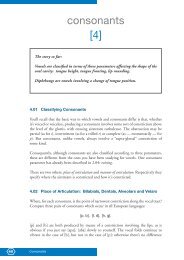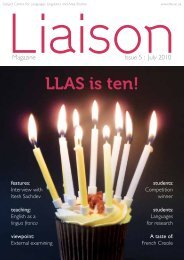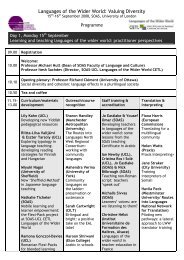PHONETICS MANUAL.indd - HumBox
PHONETICS MANUAL.indd - HumBox
PHONETICS MANUAL.indd - HumBox
Create successful ePaper yourself
Turn your PDF publications into a flip-book with our unique Google optimized e-Paper software.
the vocal tract<br />
[2]<br />
2.01 Speaking and Breathing<br />
All speech sounds in all languages are produced by modifying ordinary respiration. In<br />
quiet breathing, air enters and leaves the lungs without any obstruction, passing freely<br />
through the throat and mouth (or nose). If, however, the tongue or some other organ<br />
is placed in the path of the airstream, this free passage of air is disturbed; the air from<br />
the lungs may be set into vibration or the flow momentarily interrupted. For example,<br />
the lips close and briefly cut off the airstream for [p] and [b]. Any such disturbance<br />
generates a sound wave — a ripple effect that travels through the air between speaker<br />
and hearer(s) and is then interpreted as a particular speech sound. Articulatory<br />
phonetics studies the various ways in which airstreams can be “interfered with”.<br />
2.02 The Source of Air for Speech Sounds<br />
The LUNGS (Fig. 1) are basically sponge-like in design, except that they hold air (in a<br />
myriad of tiny airsacs), not water. When we breathe in, we enlarge the chest cavity (in<br />
part by lowering the diaphragm). This in turn expands the lungs, and air rushes in to<br />
fill the vacuum. Breathing out involves the opposite procedure. The chest is contracted<br />
and air is squeezed out of the lungs, passing through the two BRONCHI (or bronchial<br />
tubes), then through the windpipe (more technically the TRACHEA), and finally<br />
emerging in the throat.<br />
Larynx<br />
Trachea<br />
Right Bronchus<br />
Left Bronchus<br />
Fig. 1<br />
4 The Vocal Tract






